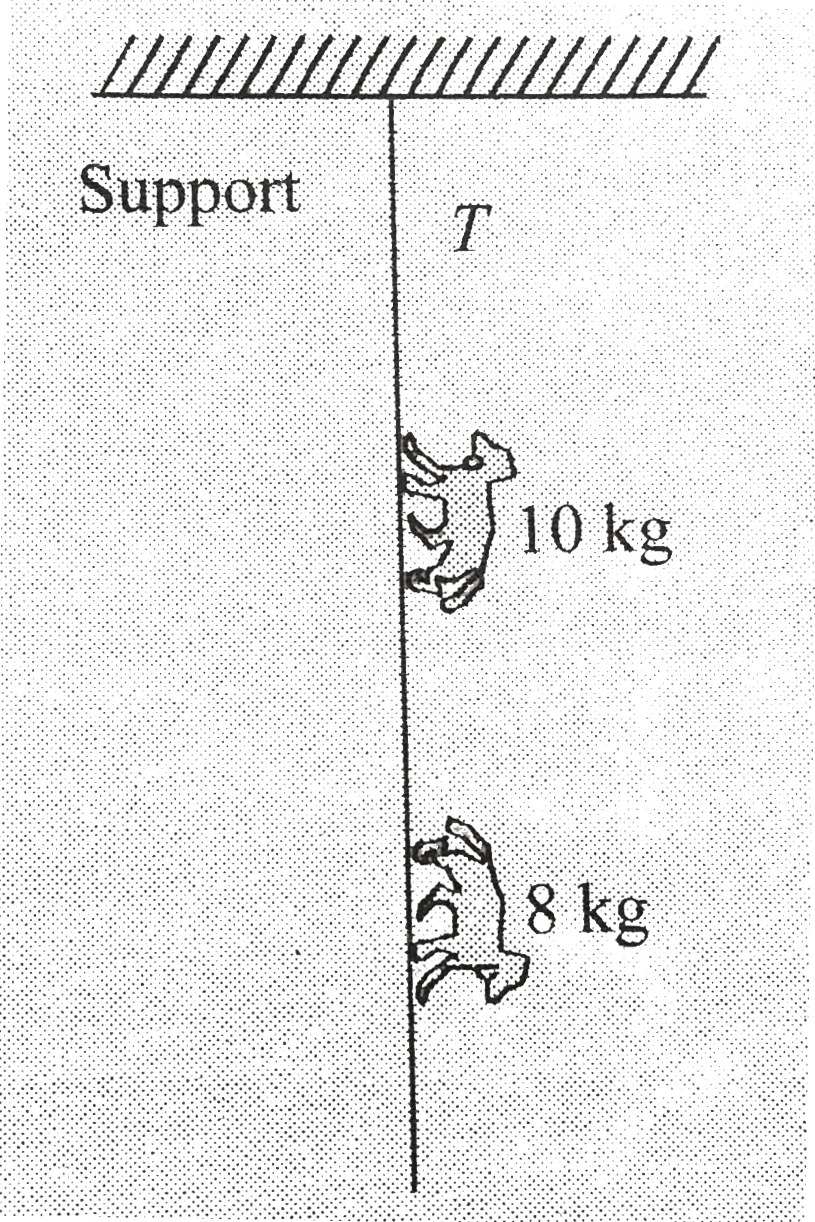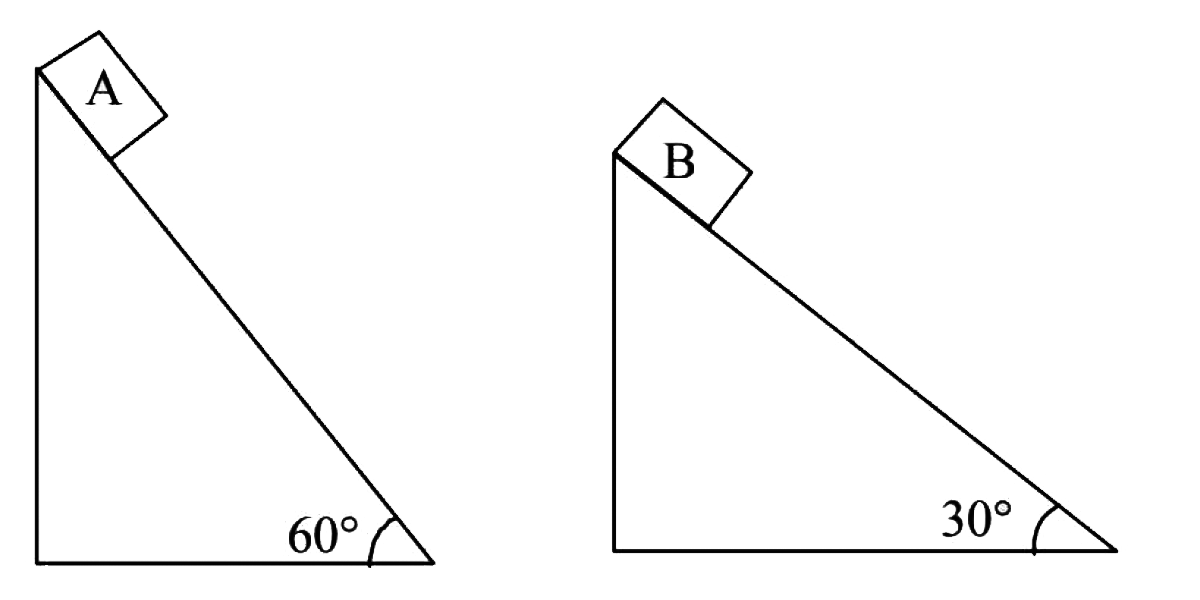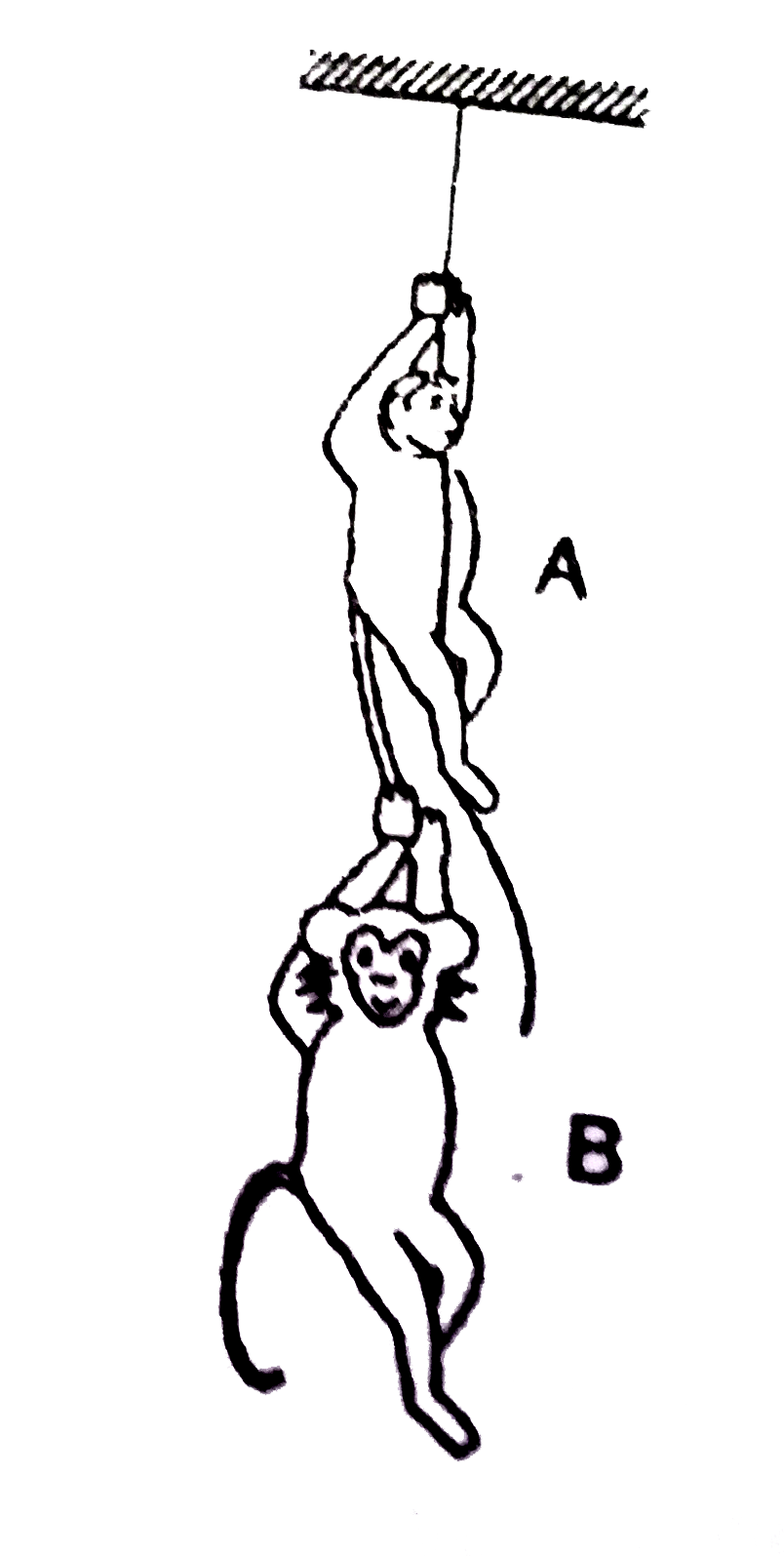Two monkey of masses 10 kg and 8 kg are moving along a verticle rope as shown in fig. the former climbing up with an acceleration of 2ms−2, while the later coming down with a uniform velocity of 2ms−1. Find the tension in the rope at the fixed support.
 Solution in Gujrati
Solution in Gujrati
180 N
200 N
80 N
216 N
The correct Answer is:B
Step by step video & image solution for Two monkey of masses 10 kg and 8 kg are moving along a verticle rope as shown in fig. the former climbing up with an acceleration of 2 ms^(-2), while the later coming down with a uniform velocity of 2 ms^(-1). Find the tension in the rope at the fixed support. by Physics experts to help you in doubts & scoring excellent marks in Class 12 exams.
Updated on:21/07/2023Topper's Solved these Questions
- NEWTON'S LAWS OF MOTION & FRICTIONBOOK - ALLEN CHAPTER - NEWTON'S LAWS OF MOTION & FRICTIONEXERCISE - EXERCISE (JM)
6 Videos
- NEWTON'S LAWS OF MOTION & FRICTIONBOOK - ALLEN CHAPTER - NEWTON'S LAWS OF MOTION & FRICTIONEXERCISE - EXERCISE (JA)
4 Videos
- NEWTON'S LAWS OF MOTION & FRICTIONBOOK - ALLEN CHAPTER - NEWTON'S LAWS OF MOTION & FRICTIONEXERCISE - EXERCISE (O-1)
50 Videos
- MOTION IN A PALNEBOOK - ALLEN CHAPTER - MOTION IN A PALNEEXERCISE - SOLVED EXAMPLE
28 Videos
- NEWTONS LAWS OF MOTIONBOOK - ALLEN CHAPTER - NEWTONS LAWS OF MOTIONEXERCISE - EXERCISE-III
28 Videos
Similar Questions
Two fixed frictionless inclined planes making an angle 30∘ and 60∘ with the vertical are shown in figure. Two blocks A and B are planes. What is the relative vertical acceleration of A with respect to B?

View SolutionA piece of wire is bent in the shape of a parabola y=kx2 (y-axis vertical) with a bead of mass m on it. The bead can slide on the wire without friction. It stays at the lowest point of the parabola when the wire is at rest. The wire is now accelerated parallel to the x-axis with a constant acceleration a. The distance of the new equilibrium position of the bead, where the bead can stay at rest with respect to the wire, from the y-axis is:
View SolutionA ball of mass m kept at the corner as shown in the figure, is acted by a horizontal force F. The correct free body diagram of ball is

View SolutionA particle thrown over a triangle from one end of a horizontal base falls on the other end of the base after grazing the vertex. If αandβ are the base angles of triangle and angle of projection is θ, then prove that (tanθ=tanα+tanβ)
View SolutionAssertion: The driver in a vechicle moving with a constant speed on a straight road is in a non-inertial frame of referance.
Reason: A reference frame in which Newton's laws of motion are applicable is non-inertial.
View SolutionTwo monkey of masses 10 kg and 8 kg are moving along a verticle rope as shown in fig. the former climbing up with an acceleration of 2 ms^(-2) , while the later coming down with a uniform velocity of 2 ms^(-2) . Find the tension in the rope at the fixed support.
View SolutionA monkey of mass 40 kg climbs on a rope which can withstand a maximum tesion of 600 N In which of the following cases will the rope break ? The monkey (a) climbs up with an acceleration of 6 ms^(-2) (b) climbs down with an acceleration of 4 ms^(-2) (c) climbs up with a unifrom speed of 5 ms^(-1) (d) falls down the rope nearly freely under gravity Ignore the mass of the rope .
View SolutionA 20 kg monkey slides down a vertical rope with a constant acceleration of 7 ms^(-2) . If g = 10 m//s^(-2) , what is the tension in the rope ?
View SolutionA monkey of 25 kg is holding a vertical rope. The rope does not break if a body of mass 30 kg is suspended with the rope exceeds 30 kg. What will be the maximum acceleration with which the monkey can climb up along the rope ? ( Take , =10 ms^(-2) )
View SolutionThe monkey B shown in fig. is holding on to the tall of the monkey A which is climbing up a rope. The masses of the monkeys A and B are 5 kg and 2kg respectively. If A can tolerate a tension of 30N in its tall, what force should it apply on the rope in order to carry the monkey B with it ?
(Take g=10ms−2)

View SolutionA monkey of mass 40 kg climbs on a rope which can withstand a maximum tension of 600 N In which of the following cases will the rope break : The monkey
(a) climbs up with an acceleration of 6ms−2
(b) climbs down with an acceleration of 4ms−2
(c) climbs up with a uniform speed of 5ms−1
(d) falls down the rope nearly freely under gravity ? (Ignore the mass of the rope.)
View SolutionA boy of mass 40 kg climbs up a rope with an acceleration of 2ms−2 . What is the tension in the rope ?
View SolutionA boy of mass 40 kg climbs up a rope with an acceleration of 2 ms−2 What is the tension in the rope ?
View SolutionA monkey of mass 40 kg climbs on a rope as shown in figure which can stand a maximum tension of 600 N. In which of the following cases will the rope break the monkey.

(a) Climbs up with an acceleration of 6 ms2.
(b)Climbs down with an acceleration of 4 ms2 .
(c )Climbs up with a uniform speed of 5 ms1 .
(d)Falls down the rope nearly freely under gravity ? (Ignore the mass of the rope).
View SolutionA monkey of mass 40 kg climbs on a rope (fig) which can stand a maximum tension of 600 N. In which of the following case will the rope break the monkey
(a) climbs up with an acceleration of 6 m s−2
(b) climbs down with an acceleration of 4 m s−2
(c ) climbs up with a uniform speed of 5 m s−1
(d) falls down the rope nearly freely under gravity
(Ignore the mass of the rope)

View SolutionA boy of mass 40 kg climbs up a rope with an acceleration of 2 ms^(-2) . What is the tension in the rope ?
View Solution
